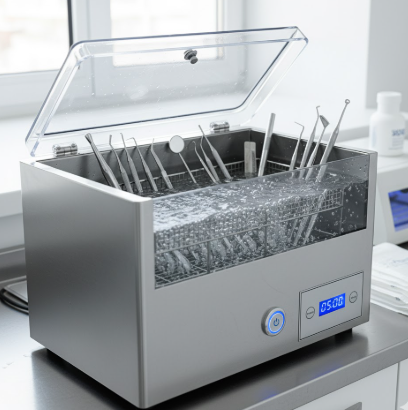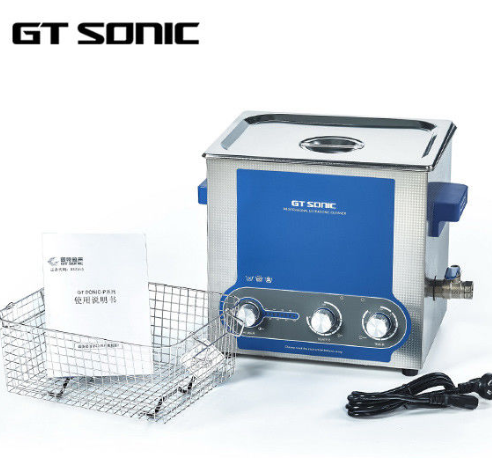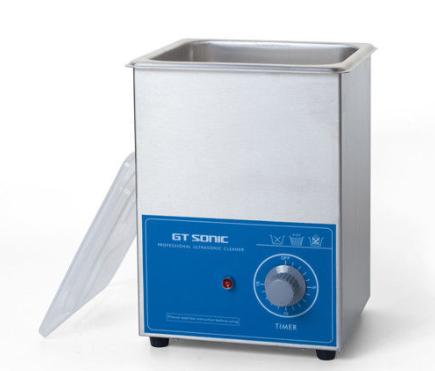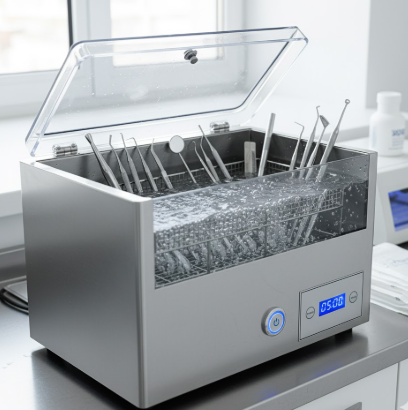Top 5 Best Ultrasonic Cleaners for Dental Instruments: Effective Cleaning Solutions
2025-11-19
Ultrasonic cleaners are essential tools for dental professionals, offering an efficient and thorough cleaning solution for dental instruments.
Ultrasonic cleaners are essential tools for dental professionals, offering an efficient and thorough cleaning solution for dental instruments. This blog explores the top 5 ultrasonic cleaners, their key features, and how they improve hygiene in dental practices. From understanding the basics of ultrasonic cleaning to choosing the right model for your clinic, this article is designed to help you make an informed purchasing decision.
What is an ultrasonic cleaner for dental instruments?
-Step-by-step procedure for ultrasonic dental instrument cleaning
-How long should dental instruments be in the ultrasonic cleaner?
What is the best method to sterilize dental instruments?
-What happens if you don't sterilize dental instruments?
-What type of instruments should be sanitized using an ultrasonic cleaner machine?
Top 5 Ultrasonic Cleaners for Dental Instruments
Key factors to consider when choosing an ultrasonic cleaner for dental instruments
-What is the volume of a best ultrasonic cleaner?
-What is the best frequency for ultrasonic cleaning?
-Ultrasonic Cleaner Solution for dental instruments
Conclusion
What is an Ultrasonic Cleaner for Dental Instruments?

An ultrasonic cleaner is a device that uses high-frequency sound waves to clean dental instruments. This process works by creating ultrasonic waves that form microscopic bubbles in a cleaning solution. When these bubbles collapse, they generate an intense scrubbing action, which helps remove dirt, debris, and bacteria from instruments.
This technology is highly effective for cleaning delicate dental instruments that manual cleaning might miss, especially in hard-to-reach areas. Ultrasonic cleaners are an essential part of modern dental practices, ensuring tools are thoroughly sanitized and safe for use.
Step-by-Step Procedure for Ultrasonic Dental Instrument Cleaning
Prepare the Ultrasonic Cleaner: Fill the ultrasonic cleaner's tank with an appropriate cleaning solution. Be sure to select one designed for dental instruments to avoid damaging the tools.
1.Submerge Instruments: Place the dental instruments in the cleaner's basket or tray, ensuring they don’t touch each other to prevent cross-contamination.
2.Set the Time and Frequency: Choose the right cleaning duration and frequency settings based on the level of contamination and the type of instrument.
3.Activate the Cleaner: Turn on the ultrasonic cleaner and allow it to run the cleaning cycle. The ultrasonic waves will work to dislodge dirt and bacteria from the instruments.
4.Rinse and Dry: Once the cleaning cycle is complete, rinse the instruments with clean water and dry them thoroughly using a lint-free cloth or air-drying machine.
How Long Should Dental Instruments Be in the Ultrasonic Cleaner?
Typically, dental instruments should be cleaned for 5 to 15 minutes, depending on the type and level of contamination. More delicate instruments or heavily soiled tools may require longer cleaning times, while routine cleaning of basic dental tools may be faster. It's important to follow manufacturer guidelines for specific instruments to avoid overexposure to ultrasonic waves.
What is the Best Method to Sterilize Dental Instruments?

Sterilization is crucial to ensure dental instruments are free from harmful microorganisms. While ultrasonic cleaning removes debris and dirt, sterilization ensures that any remaining bacteria or viruses are destroyed. The best method for sterilization is autoclaving—a process that uses high-pressure steam to eliminate pathogens.
What Happens If You Don’t Sterilize Dental Instruments?
Failing to sterilize dental instruments properly can lead to cross-contamination and the spread of infections. In a dental setting, unsterilized tools can transmit bacteria, viruses, or fungi from one patient to another, potentially causing serious health risks. This is why proper sterilization after cleaning is essential for patient safety.
What Type of Instruments Should Be Sanitized Using an Ultrasonic Cleaner Machine?
Ultrasonic cleaners are ideal for a variety of dental instruments, including:
1.Handpieces: Dental drills and scalers that require fine cleaning.
2.Mirrors and Probes: Items with delicate surfaces or grooves.
3.Forceps and Scalers: Tools that may have small joints or intricate parts.
4.Impression Trays: Removing debris and contaminants before sterilization.
5.Orthodontic Tools: Brackets, bands, and other metal parts requiring gentle cleaning.
Top 5 Ultrasonic Cleaners for Dental Instruments

1. GTSONIC Dental Ultrasonic Cleaner
Frequency: 40 kHz, ideal for delicate dental instruments.
Tank Size: 3.2 liters, suitable for small to medium dental clinics.
Material: Durable stainless steel tank for easy cleaning.
Additional Features: Adjustable time and temperature settings for precision cleaning.
- Pros: Quiet operation, energy-efficient, and reliable performance.
- Cons: Smaller tank may not be ideal for high-volume clinics.
2. Branson M3800 Ultrasonic Cleaner
Frequency: 37 kHz for fine and deep cleaning.
Tank Size: 3.8 liters, perfect for medium-sized dental clinics.
Material: Stainless steel construction, corrosion-resistant finish.
Additional Features: Digital timer, temperature control, and degassing function.
- Pros: Offers both delicate and powerful cleaning, customizable settings.
- Cons: Higher price point compared to basic models.
3. iSonic P4820 Ultrasonic Cleaner
Frequency: 40 kHz for gentle yet effective cleaning.
Tank Size: 2 liters, ideal for smaller dental practices.
Material: Stainless steel with anti-corrosion coating.
Additional Features: Simple control panel for easy operation.
- Pros: Affordable, compact, and efficient for smaller practices.
- Cons: Limited capacity may not suit larger practices.
4. Mettler M-DSH-13 Ultrasonic Cleaner
Frequency: 30 kHz for standard cleaning performance.
Tank Size: 5 liters, great for busy dental offices.
Material: Stainless steel construction.
Additional Features: Timer and temperature control for consistent results.
- Pros: Reliable, cost-effective, and easy to maintain.
- Cons: No digital display, which can make it less intuitive for some users.
5. Hu-Friedy Elara 30 Ultrasonic Cleaner
Frequency: 28 kHz, excellent for heavy-duty cleaning.
Tank Size: 10 liters, ideal for large clinics or multi-chair practices.
Material: Industrial-grade stainless steel for durability.
Additional Features: Programmable cycles and temperature control.
- Pros: High capacity, robust performance, great for high-volume practices.
- Cons: Bulkier and pricier compared to smaller models.
Key Factors to Consider When Choosing an Ultrasonic Cleaner for Dental Instruments

When selecting an ultrasonic cleaner for your practice, several important factors should influence your decision. The right cleaner will ensure that your instruments are cleaned efficiently, effectively, and safely.
What is the Volume of the Best Ultrasonic Cleaner?
The volume of an ultrasonic cleaner’s tank is an essential consideration. For smaller practices or clinics, a tank size of 2–5 liters may be sufficient. However, for larger clinics that clean multiple instruments at once, you may need a model with a 10-liter tank or larger. Larger tanks allow you to clean more instruments at once, improving efficiency in high-demand environments.
What is the Best Frequency for Ultrasonic Cleaning?
The frequency of the ultrasonic waves plays a crucial role in determining the effectiveness of the cleaning. For dental instruments, the ideal frequency range is generally between 28 kHz and 40 kHz.
1.28 kHz–33 kHz: Best for heavy-duty cleaning of larger instruments, such as handpieces and forceps.
2.35 kHz–40 kHz: Perfect for delicate instruments like mirrors, probes, and orthodontic tools.
Ultrasonic Cleaner Solution for Dental Instruments
The cleaning solution used in the ultrasonic cleaner can significantly impact the effectiveness of the cleaning process. For dental instruments, it's essential to use a solution that is specifically formulated for dental use. These solutions are designed to break down organic materials, such as blood, oils, and saliva, without damaging the instruments. Always follow the manufacturer’s recommendations for cleaning solutions to achieve the best results.
Conclusion
Choosing the right ultrasonic cleaner for your dental practice depends on several factors, including the size of your clinic, the volume of instruments, and the specific features you need. The GTSONIC Dental Ultrasonic Cleaner and Branson M3800 Ultrasonic Cleaner are both reliable and efficient for medium-sized practices, while the Hu-Friedy Elara 30 is perfect for high-volume settings. By selecting the right model, dental professionals can improve cleaning efficiency, meet health standards, and ensure patient safety.
Recommended Reading
1.GTSONIC Ultrasonic Cleaner for Dental Instruments: Ideal for Clinics and Laboratories
2.Why Choose the GT-X3 Ultrasonic Dental Cleaner for Your Practice
3.Ultrasonic Glasses Cleaner :The Complete Guide to Cleaning Your Eyeglasses









